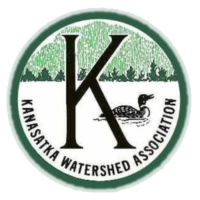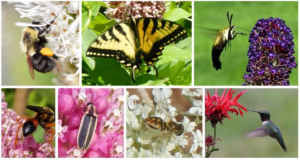
Who Are the Pollinators? NH’s Super Seven 2/27/20. Credit: UNH Extension
Famous biologist Edmund O. Wilson once called insects “the little things that run the world.” He argued that without insects, most flowering plants would disappear because they are pollinated by insects. The food web that supports amphibians, reptiles, fish, birds, mammals (including humans) would quickly collapse. And the biosphere would rot due to the loss of the insects that consume dead plant and animal matter. Most people don’t realize that even seed eating birds feed caterpillars to their young.
Insect populations are plummeting due to the loss and degradation of habitat, the quest for blemish-free lawns and flowers by using pesticides, and climate change. There are things we can do to help, whether it is in our individual yards or at the community level and beyond. Among the best approaches:
- Convert lawns into diverse natural habitats
- Grow native plants adapted to local climates and rainfall patterns
- Leave the leaves and dead flower stalks to provide nesting sites and shelter
- Eliminate pesticide use for cosmetic purposes
- Turn off the lights at night
In short, the landscaping and gardening practices that benefit our lake and help to control erosion and runoff are the same practices that are good for pollinators, which are in turn good for birds. It’s all one food web and one ecosystem with intricately meshed components. Whether you come to this realization as a lifelong gardener, a lover of clean lakes, a bird watcher, a fan of fireflies on a summer evening, or an appreciator of the lovely Monarch butterfly, your actions as stewards of your own yard can make a difference.
- Why We Need Insects and Other Invertebrates—The Xerces Society
- Nesting and Overwintering Habitat for Pollinators and Other Beneficial Insects—The Xerces Society
- Planting for Pollinators: Establishing a Wildflower Meadow from Seed—University of New Hampshire Extension
- Native Pollinator Plants by Season of Bloom—Wild Seed Project
- Native Plants That Attract Pollinators—New England Wildflower Society and Grow Native Massachusetts
- Native Plants for Pollinators and Other Beneficial Insects Northeast Region—The Xerces Society
- Native Trees and Shrubs for Pollinators—Heather Holm, Grow Native Massachusetts
- Native Perennials for Pollinators—Heather Holm, Grow Native Massachusetts
Bees
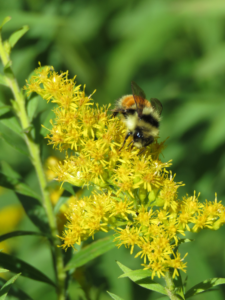
Bombus ternarius (Tricolored Bumblebee) on goldenrod, 9/6/18. Credit: Steve Robertson, Superior National Forest.
Additional Information About How to Support Bees
Bumblebee Conservation—The Xerces Society
Native Plants to Support Massachusetts Bumblebee Species at Risk—Dr. Robert Gegear
Simple Steps for Buying Bee-Safe Plants—The Xerces Society
Bee-Safe Nursery Plants—The Xerces Society
Butterflies
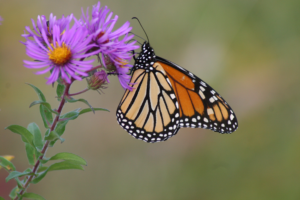
Danaus plexippus, Monarch Butterfly on New England Aster, Great Bay National Wildlife Refuge, Newington, NH, 10/3/2006. Credit: Greg Thompson, U.S. Fish and Wildlife Service.
Additional Information About How to Support Butterflies
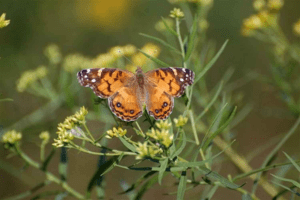
Vanessa virginiensis (American Painted Lady), 2/26/2013. Credit: Tetzner Thomas, U.S. Fish and Wildlife Service.
Common Butterflies of New England—Tufts Pollinator Initiative
New Hampshire Butterflies—Butterfly Identification.org
Monarch Nectar Plants Northeast—The Xerces Society
Native Plants that Feed our Butterflies and Birds—From Bringing Nature Home, Doug Tallamy
Fireflies
Additional Information About How to Support Fireflies
Firefly Conservation: A Guide to Protecting the Jewels of the Night—The Xerces Society
